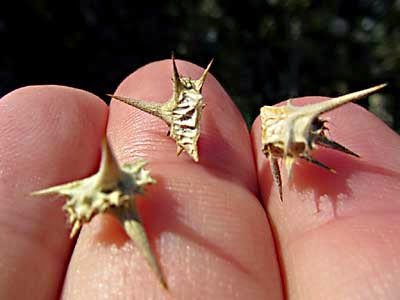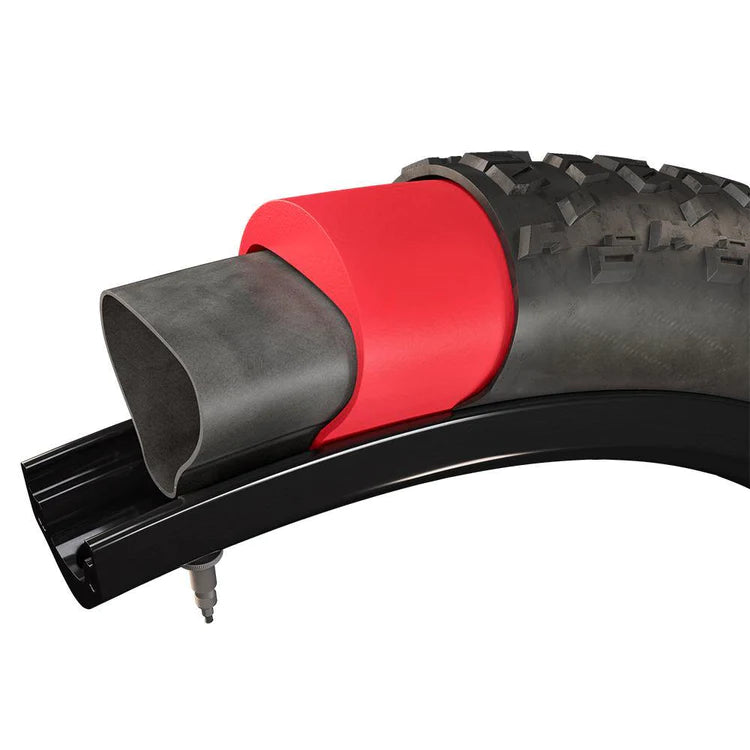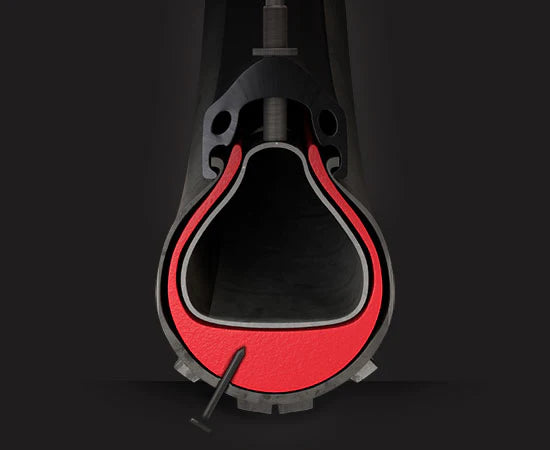
How to Thorn-Proof Your Bike
By Bob Forgrave
President, Flatbike
It’s a sunny day, you’ve got the time off, your bike is calling you…and it’s got a flat tire. And the bike pump is … somewhere. If this has ever kept you from getting out on a bike, then here’s exactly what you need. Here, on one comprehensive page, are five ways to thorn-proof your bike, from the simple to the hilariously expensive…
A few weeks ago, I got a call from Randy, a private pilot who likes to fly his CHANGE folding mountain bike into remote places for exciting adventures in his private plane. He wanted tips on how to avoid thorn flats.
How remote? And what kind of vegetation are we talking about?

Cacti in West Texas can have some awfully long thorns…
Those are some serious spikes. And West Texas cacti aren’t the only problems. Blackberries, devil’s club, goathead thorns, ‘wait a minute’ vines…nearly all parts of the country have some species that are unfriendly to inflated tires.
Basically, if you know you’re headed into thorn country, there are five different ways to address the issue of puncture flats.
1. What you already have, just tougher.
Tires and inner tubes come in thicker, thorn-resistant versions, which are tougher for thorns or broken glass to puncture. Why don’t all bikes come like this? Because extra rubber results in extra weight. How much do you want to free yourself from flats?
Using a set of these in the 80’s, I once went over 2,000 miles between flats; when I finally got one, it was from a thumbtack inserted in the sidewall at a bike rack. Even the best intentions won’t stop everything…
The Specialized Armadillo tire series has different levels of rubber thickness, with more thickness protecting more, but also offering a bit stiffer ride. The Continental Gatorskin, on the other hand inserts a layer of Kevlar clear around the tire to protect against anything–perhaps even sidewall thumbtacks.

Kevlar: If it can stop bullets, it can stop thorns.
You can also protect against thorns at the inner tube level. But thicker tubes are becoming harder to find in recent years.

Kenda owns a large portion of the thorn-resistant tube market.
FLATBIKE ASSESSMENT: Good, easy plan. We include Continental Gatorskin flat-resistant tires standard on our Flatbike Century folding road bike.
2. Self-healing tires that aren’t science fiction.
The idea is simple. A small amount of liquefied goo stays inside your tire. When you get a puncture and the air starts leaking out, the goo rushes to the opening and clogs it.
In practice, this often works, especially if the hole is small enough, the hole is on the bottom of the tire, and the self-sealing compound in your tire is recent enough to be still liquid.

Otherwise, you end up with this inside your tires (The “tire coral”, not the money).
If you go with this approach, you probably want a tubeless tire, because there’s simply no way to change the liquid inside an inner tube. Notable self-sealing solutions are Slime and Stan’s. The website MBAction has a great review of these and other sealant solutions, with the wonderful testing warning, ‘All tires were harmed during the testing process.’
FLATBIKE ASSESSMENT: Wait & see. Some folks swear by the tire sealant approach, and we’re interested to hear from you. But a tubeless tire works best with a compatible rim. Useful extra aids are a bucket of soap water, a sponge, and an air compressor. And after that, we wonder if the time previously spent fixing flats on the road is simply transferred to garage maintenance, installing and removing old filler.
3. A solid choice for narrower tires?
For a while, before my thorn-resistant tires, I rode a 1980’s technology, solid rubber tire. Potholes were memorable on my spine, but traction was good and I never got a flat.
On the surface, an update to this approach sounds appealing. Flat tires are the #1 maintenance issue bringing customers into many bike shops.
That said, compressed-air tires distribute a shock across the entire rim, while solid tires distribute stress only locally. And some bike shops charge a premium for replacing a solid tire. Has advanced technology made a difference?
With today’s advanced polymers, there are more options and better options than ever. One example is the Tannus Airless Tire. Made of closed-cell polymer foam, it is reportedly as light as most tire/tube combos, good for over 5,000 miles and comes in 12 stylish colors. Tannus even claims equivalent rolling resistance to inflated tires.

No more flats. Ever.
During Bike Expo NY 2018, a Tannus rep offered to put a set of Tannus airless tires on a CHANGE 702 folding commuter bike, which I then rode in the 40-mile Five Borough Tour, plus another 20 riding to and from the event.
After a 60-mile day, I must say that the difference between the solid rubber tires of the 1980’s and the carefully calibrated polymer tires today could not be more stark. Even a cobblestone road was possible at 15 mph–still not fun on narrow tires, but the choice of tire composition was never in question after the first few wheel rotations.

Among the joys of that 10-mile pre-ride was a surprise section on this road. It felt just like a regular air tire!
FLATBIKE ASSESSMENT: Airless tires will remain more difficult to install/uninstall than inflated tires. But not by much, with the right tool. And it’s a one-time deal.
Last we’ve heard, there’s also about a 5% loss in rolling efficiency. If you keep your tires fully inflated all the time, pumping up for every ride, these aren’t for you. But if you often go weeks between fill-ups, adding 20 lbs or more when you fill up, then you’re going to experience an increase in rolling efficiency. We’ll continue to explore this area as it matures.
4. Like solid tires, but not.
We got this tip from a reader–thanks, Donny–and it has developed into a brilliant idea that’s worth a category all its own. But first, let’s take a step back and look at what riders (road and MTB) actually do with their tires.
Road riders have a preferred pressure that must be maintained over time for maximum efficiency. They rack up many miles on pavement that may occasionally have a pothole, broken bottle, or goathead thorn. Under low pressure, ‘pinch flats’ may also occur, without any obstacle in the way.

Goathead thorns: Nasty stuff.
MTB riders, on the other hand, vary their terrain–one day dirt trails, another day lots of bumps and big jagged rocks–so their tire pressure varies accordingly. The rockier the terrain, the more pliable you want your tire to avoid punctures and increase grip. Broken glass isn’t usually an issue, but goathead thorns and cactus thorns are worse.
So while an airless tire might make sense for a road bike rider, it would take away the ability for MTB riders to adjust pressure for different terrain. Enter a new category: the tire liner.

A tire liner goes between your tire and innertube, protecting against puncture.
A tire liner can be inexpensive. The one shown here from Mr Tuffy is just ten bucks, with a 70% satisfaction rating. Folks have ridden over 1000 miles with it, and even ‘successfully’ run over broken glass. (And “Ed” in the comments has an even cheaper solution that may be more reliable.)
But it’s still not flat-proof. And you can create your own flats, both from semi-inflated tires (pinch flats) and from having your rim liner slide to the side and rough edges puncture your inner tube (anyone have a name for that?). And tire liners are no match for goathead thorns.
Now here’s where it gets really interesting. Suppose you took the inflated tire idea, and the foam solid tire idea, and the liner idea, and melded them together into a single product that inflated but was thick enough for goathead thorns?

Tannus Armour: an MTB-focused liner that’s finally designed for goathead thorns.
The Tannus Armour is a special type of liner–the red part–with 15 mm of the Tannus solid-tire material under the tread of the tire, and 2mm on the sides. It’s like having most of the advantages of an airless tire, plus the ability to adjust pressure to your terrain.

Normally, this is a ride-ending disaster. Not with Tannus Armour.
Even in the worst case scenario, with a random goathead thorn doing a stealth insertion from the side that goes through tire, 2 mm liner, and inner tube, giving you a flat…you still have 15 mm of solid tire to ride back on, protecting your rim from rock damage.
FLATBIKE ASSESSMENT: We cannot pass this up. We are now offering Tannus Armour at Flatbike, both separately and as an add-on to our our full-size folding mountain bikes. We now offer Tannus Armour for 20″, 26″, and 27.5″ wheels.
5. And now for something completely different…
What if price were no object, and you could just optimize for the ride on your own wheel? This is the idea behind the Energy Return Wheel.
According to company literature, not only does this completely flat-proof option perform as well as a standard mountain bike wheel, but it outperforms a standard wheel, particularly on uphills. Available for the low, low price of just $2,699 from EnergyReturnWheel.com.
FLATBIKE ASSESSMENT: Hmmm. That’s…different. Can we still afford the rest of the bike? And do we have to clean the insides of the tires after a ride?
Overall, that’s five different ways to solve the flat-tire problem. Which one works best for you?
See you on the trails!
Bob Forgrave is president of Flatbike, an
ecommerce company offering full-size folding bikes
and kits to make any bike take up half the space.


